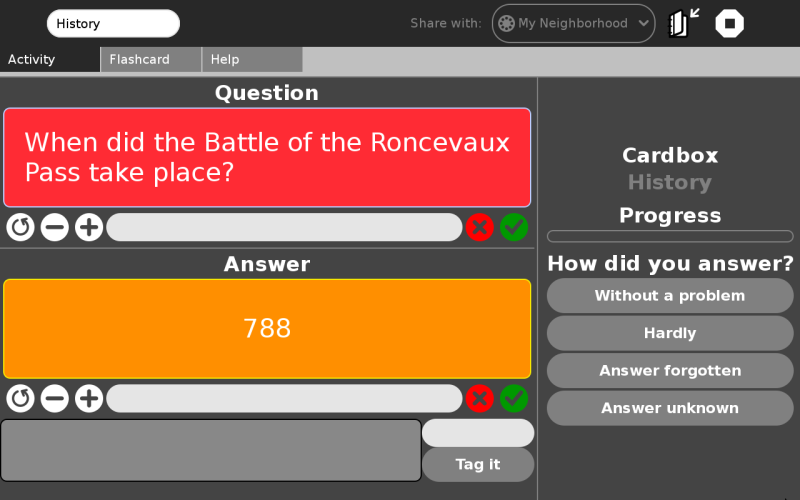Assimilate: Difference between revisions
(Added explanation about hints) |
mNo edit summary |
||
| Line 79: | Line 79: | ||
I've bundled the activity here: |
I've bundled the activity here: |
||
[[Media:Assimilate- |
[[Media:Assimilate-10.xo]] |
||
== Contact Me == |
== Contact Me == |
||
Revision as of 08:34, 18 June 2008
Assimilate for OLPC
Motivation
After using so many free as in free speech tools, I wanted to contribute to the cause and learn the inner workings of open source development. Seeing that currently in the OLPC project there is no good old fashioned flashcards like activity, I decided to create one by myself but trying to apply some ideas and concepts of constructivism theory as suggested in Nicholas Negroponte's "Being Digital" or Seymour Papert's "Children's Machine" books.Instead of relying on pure memorization, tools to assimilate concepts within the cards and how they relate to each other are offered.
The user will have the chance to build her own knowledge and will merge what she might have created for a given subject with content build by other users. Thanks to this wisdom of the crowd or collective intelligence, appropriate and noteworthy bits of information will prevail. Computers manage information while knowledge is managed by people.
Description
The assimilate activity is a flashcards based activity with a constructivist touch. Based on Leitner's spaced repetition system, this activity adds too some ideas of constructivist theory in order to assimilate new knowledge more efficiently and help the students construct new flashcards by themselves. By reaching consensus, either by discussing answers in the classroom or by merging the content added by students individually, the questionnaires will be somehow validated with only little guidance needed by the teacher, who could later check how much ease or trouble each flashcard offered and analyze the relations created amongst different flashcards through tag grouping or by having similar answers (even if they pertain to very different topics)
Instead of using flashcards to memorize the information, the idea is to help children learn the concepts in their own terms by redefining or rephrasing questions and answers and show them that information with context is knowledge.
Hints
Sometimes we know the answer but we cannot recall it. Five different kind of hints are offered in this activity to help you reach this knowledge that belongs to you.
- Flashing the answer: shows the answer in a small fraction of time to trigger visual memory
- Rapid Serial Visual Presentation: Similar to the flash hint, shows the answer word by word quickly
- Scrambled words: There are three ways o randomize the letters in the answer
- Watch the answer partially: each step shows one letter
- Related card: There is some criteria to related some cards; by consulting a related card, one might guess the answer
Hints reduce the amount of punctuation one gets while answering the card, but might help assimilate the answer better in your brain for the next time.
Screenshot
Roadmap
- I've already coded the basic functionality to use it as a either standalone activity or in collaboration mode
- It's working under sugar-jhbuild and emulation with QEMU
- The database is also completed with triggers added to implement foreign key references (sqlite lacks FK support)
- A very simple Leitner system implementation is coded.
- As a hint, a related question can be seen, even if it's not on the same cardbox
- More hints are offered to help reach the answer
- Preliminary use of presence and telepathy libraries is finished, activity can be shared and collaboration works.
- As this is somehow based on the so-called WEB 2.0 concept, feedback of potential users of the activity would be much appreciated; it's all about the users.
Features
- Creation of questionnaires and their flashcards, with multiple questions and answers in each card.
- Tagging of the flashcards to categorize and relate them.
- To help children associate content, each question and answer is showed with the colors of the buddy who created them.
- Each added question and answer should be evaluated according to some criteria to decide whether is correct or incorrect
- Whenever more than 3 incorrect answers are in the flashcard, the question could be used in test quiz mode.
- Hints to help students remember the answers in the form of mnemotecnic tricks.
- Collaboration and sharing of cards to allow children build their own content and reach consensus by 'wisdom of the crowd'
- Using gestalt pattern matching similar text strings can be related
Technology Choice
- SQLite to store the data
- PyGTK for the frontend of the application.
- Telepathy tubes for sending/receiving data.
Status Update
Code is already in the git respository: http://dev.laptop.org/git?p=activities/assimilate;a=summary
I've bundled the activity here: Media:Assimilate-10.xo
Contact Me
My name is Urko Fernandez. Comments, criticism and ideas are always welcome in the discussion page or at - tturktime - AT - gmail.com. (where ' - AT - ' = @, to avoid spam email scanners)
